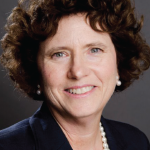
Last month I mentioned I would be addressing the ACR efforts concerning healthcare with this column, but given the timing of our Advocates for Arthritis fly-in—we should be in Washington, D.C. as you read this—I felt healthcare would be better addressed after our time on The Hill (although I encourage you to read Dr. Pisetsky’s healthcare-focused editorial on p. 6). Instead, this month I’m partnering with the ARHP president to discuss the ACR/ARHP organizational approach using the multidisciplinary team model that many of you are no doubt familiar with.
Through both of our day jobs, we know that a multidisciplinary team is imperative for the successful treatment of patients with rheumatic disease. The ACR/ARHP believes the same approach is imperative for a professional society to successfully represent the rheumatology community. If you’ve been a member for any length of time, you know that our membership comprises rheumatologists, scientists, nurse practitioners (NPs), physician assistants (PAs), nurses, physical and occupational therapists, pharmacists, and many other disciplines. As a specialty medical society, the ACR is arguably a leader when it comes to welcoming other health professionals to be members through its ARHP division. By being inclusive, the ACR has created a unique rheumatology environment where physicians and health professionals can interact, collaborate, create, and share.
Over the last several years, there has been tremendous growth of the ARHP and now it has a membership of 1,215. The recognition of a potential shortage of rheumatologists has driven the demand for NPs or PAs to provide rheumatologic care. These providers now make up an increasing percentage of ARHP membership and have played a significant role in modifying the ACR’s approach to education, advocacy, and clinical practice.
Successful Collaboration Benefits the Membership
The ACR has a number of committees that work closely with staff to conduct the organization’s work, and every one includes at least one health professional. Whether the volunteer group works on one of our standing committees, task forces, or sections, the inclusion of one or more health professionals ensures that crucial expertise is represented. Examples of successful collaboration include the recent expansion of Arthritis Care & Research from six to 12 issues under the leadership of the Committee on Journal Publications; the launch of the Rheumatology Image Bank incorporating health professional images not included in past collections; and the merger of all advocacy initiatives under one Government Affairs Committee.
In turn, the ARHP has added rheumatologists to its Executive Committee, Membership and Nominations Committee, Annual Meeting Program Subcommittee, E-Learning Subcommittee, and numerous other task forces and editorial teams. Having a rheumatologist’s input on health professional practice issues, for example, will result in enhancements to future online educational offerings. Already, specific speaker recommendations have been used for the upcoming 2010 Annual Scientific Meeting in Atlanta.
Education Is Enhanced for All
The content for the ACR/ARHP Annual Scientific Meeting is selected by both the ACR annual meeting planning subcommittee and the ARHP annual meeting program subcommittee. Sixty multidisciplinary volunteers develop more than 250 scientific sessions, 45 workshops, 100 meet-the-professor sessions, 2,000 abstracts, and countless networking forums for the more than 15,000 registrants. Although the ACR and ARHP meetings are planned by different committees, representatives from each committee serve on the other committee. Both committees consider all audience members in their planning work. As a result, meeting attendees can participate in activities from both programs and benefit from the expertise of varied physician and health professional speakers and abstract presenters. The annual meeting also provides a forum for interdisciplinary research and practice collaboration. Additionally, members and nonmembers can access the annual meeting online via SessionSelect following the meeting. Interdisciplinary education has certainly contributed to the success of the annual meeting as the premier rheumatology meeting.
Other multidisciplinary educational offerings include the online NP/PA Postgraduate Rheumatology Training Program and the Advanced Practice Skills Training Course offered in conjunction with the ACR State-of-the-Art Clinical Symposia. Created by a physician and health-professional team of editors, presenters, and reviewers, both activities were developed in direct response to the ACR Workforce Study, which displayed an urgent call for practice redesign as a way to improve patient care. Both offerings are are intense training activities designed to accelerate the training process of rheumatology nurse practitioners and physician assistants. The availability of these activities helps physicians to overcome hesitancies regarding the integration of interdisciplinary teams, based on concerns that they do not have the time required to provide on-the-job training to nurse practitioners and physician assistants.
The NP/PA program features 19 online modules that address the training needs of NPs, PAs, fellows-in-training, and other clinicians. Since its release in December 2008, the training program has enrolled 179 NPs and PAs; 50 have graduated. The Advanced Practice Skills Training Course provides participants hands-on training in performing proper examinations for musculoskeletal abnormalities, joint tenderness, and swelling, as well as instruction on how to use scoring tools such as the Health Assessment Questionnaire and Disease Activity Score for 28 Joints. Additionally, the course offers hands-on training for joint aspiration and injection. This course has been offered twice and registration has reached capacity both times.
Going forward, the ACR and the ARHP will be working together to revise both programs and to develop new online education for nurses new to rheumatology practice. The proposed nursing program would provide an overview of all rheumatic diseases, assessment of patients, treatment of patients, infusion of patients, and insurance preauthorization. By working together in multidisciplinary teams, the ACR and the ARHP are creating online education for the current and future rheumatology workforce.
With its diverse membership, the ACR encapsulates the spirit of a multidisciplinary care team, bringing rheumatologists and rheumatology health professionals together and fostering interaction, collaboration, creativity, and sharing. As a result, the ACR, the rheumatology specialty, and patients with rheumatic diseases all benefit.
Dr. Cohen is president of the ACR. Contact him via e-mail at [email protected]. Dr. Ehrlich-Jones is president of the ARHP. Contact her at [email protected].


